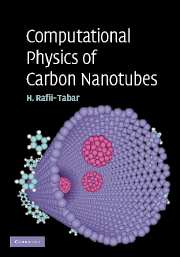Book contents
- Frontmatter
- Contents
- Preface
- 1 Introduction
- Part I
- 2 Formation of carbon allotropes
- 3 Nanoscale numerical simulation techniques
- 4 Interatomic potentials and force-fields in the computational physics of carbon nanotubes
- 5 Continuum elasticity theories for modelling the mechanical properties of nanotubes
- 6 Atomistic theories of mechanical properties
- 7 Theories for modelling thermal transport in nanotubes
- Part II
- References
- Index
3 - Nanoscale numerical simulation techniques
Published online by Cambridge University Press: 29 September 2009
- Frontmatter
- Contents
- Preface
- 1 Introduction
- Part I
- 2 Formation of carbon allotropes
- 3 Nanoscale numerical simulation techniques
- 4 Interatomic potentials and force-fields in the computational physics of carbon nanotubes
- 5 Continuum elasticity theories for modelling the mechanical properties of nanotubes
- 6 Atomistic theories of mechanical properties
- 7 Theories for modelling thermal transport in nanotubes
- Part II
- References
- Index
Summary
Nanostructures form the building blocks in nanoscale science and nanoscale technology. These structures operate at highly reduced energy, length and time-scales. They are ultra small for direct observation and measurement, yet may be too large to be described completely by quantum-mechanical computational techniques. Therefore, predictive computer-based numerical modelling and simulations to study their energetics and dynamics, and nanoscale processes, have come to play an increasingly significant role in the conceptual design, synthesis, manipulation, optimisation and testing of functional nanoscale components, nanostructured materials, composed of nanosized grains, and other structures dominated by nanointerfaces. The importance of these computational approaches, from the perspective of nanoscience and nanotechnology, rests on the fact that they can provide essentially exact data pertinent to nanoscale model systems which, as a result of the reduced energy, length and time-scales involved, may be very difficult to obtain otherwise.
Many key questions in nanoscience are related to the properties of the constituent nanostructures. It is known that the stability of the different phases is altered in the nanometre regime, which is influenced by both kinetic and thermodynamic factors. Therefore, we need to investigate the mechanics and thermodynamics of phase transformations in nanostructures. Many mechanical, thermal and electronic properties of nanoscale building blocks vitally depend on the size, shape and the precise geometrical arrangement of all the atoms within the block.
Information
- Type
- Chapter
- Information
- Computational Physics of Carbon Nanotubes , pp. 43 - 90Publisher: Cambridge University PressPrint publication year: 2007
